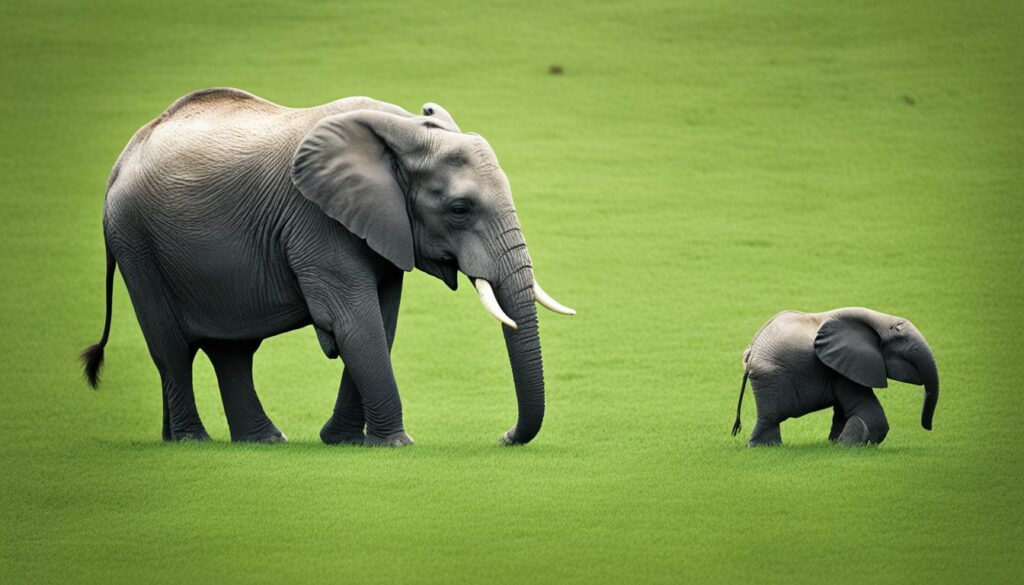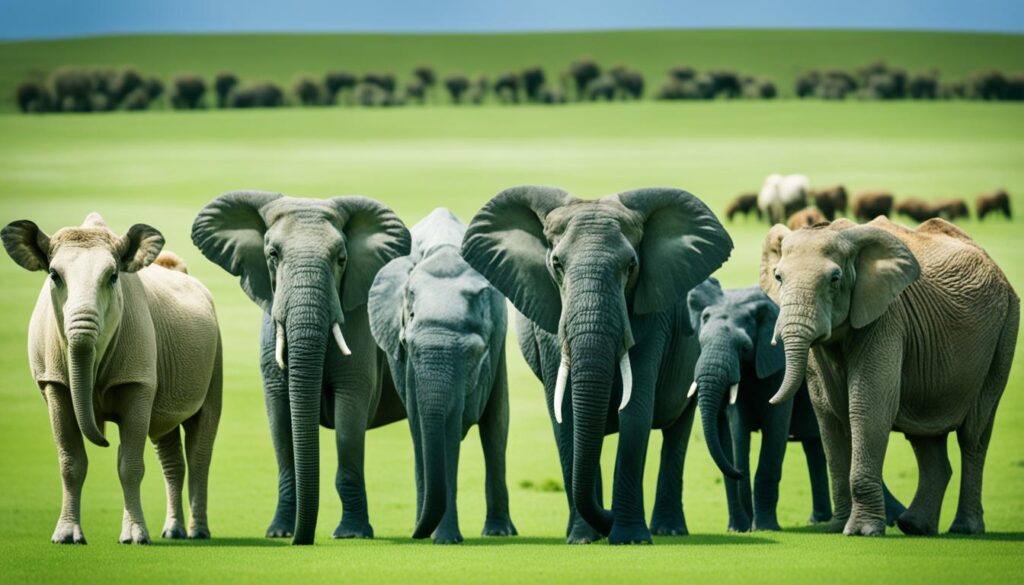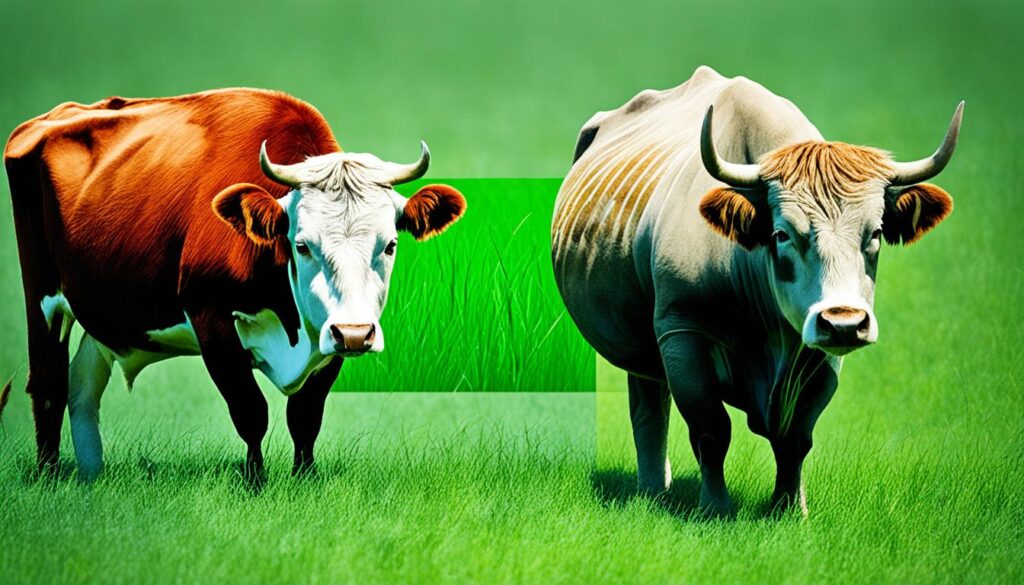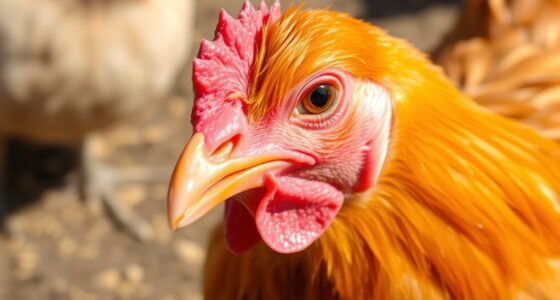Did you know that many major mammal groups have experimented with grazing on grass over the past 4 million years? It’s true! But here’s the surprising part: while some animals have stuck with grazing, others have switched back to browsing on trees and shrubs, and some have even gone extinct.
A recent study conducted by the University of Utah has shed light on the diversity of animal responses to the availability of grasses in Africa. Bovid species like cattle, buffalo, and antelopes still primarily graze on grass, but other animals, such as elephants and spiral-horned antelope, have shifted to browsing. Some species, like Asian elephants, went extinct in Africa but still survive in Asia where they graze but also browse. This study challenges assumptions about the diets of these animals and shows that the present is not necessarily indicative of the past in terms of what animals eat.
Key Takeaways:
- Many major mammal groups have experimented with grazing on grass over the past 4 million years.
- Some animals have switched back to browsing on trees and shrubs, while others have gone extinct.
- Bovid species like cattle, buffalo, and antelopes still primarily graze on grass.
- Elephants and spiral-horned antelope have shifted to browsing.
- The study challenges assumptions about the diets of these animals and shows that the present is not necessarily indicative of the past.
The Grazing Experiment
The University of Utah study revealed fascinating insights into the grazing behaviors of African mammals over the past 4 million years. During this period, numerous mammal groups attempted to incorporate grass into their diets. However, as the study found, not all animals were successful in their transition to grazing. Some species went extinct or reverted to browsing on trees and shrubs.
Interestingly, the bovids, which include iconic African animals such as cattle, buffalo, sheep, wildebeest, and certain antelopes, are the only major group that still predominantly graze on grass today. They have maintained their evolutionary adaptation to consume grasses throughout their existence. This suggests that bovids have successfully harnessed the nutritional benefits offered by grass as a food source.
However, it is crucial to note that the present dietary preferences of certain animals may not accurately reflect their past behaviors. The University of Utah study discovered that animals like elephants and antelopes had different diets 2 million years ago compared to what they have today. This indicates that dietary adaptations and preferences have shifted over time, influenced by various factors such as environmental changes and competition for resources.
The Diversity of Grazing and Browsing
The University of Utah study conducted in the Turkana Basin in Kenya and Ethiopia unraveled the fascinating diversity of grazers and browsers that existed between 4.1 million to 2.35 million years ago. This period witnessed a remarkable range of mixed feeders, animals that both grazed and browsed on vegetation. However, the grazing populations underwent significant changes over time, leading to the dominance of bovids as the primary grazers in present times.
In the Turkana Basin, from 2.35 million to 1 million years ago, the population of grazers was larger compared to the present scenario. However, in the past 1 million years, many grass grazers either transitioned to browsing or went extinct, leaving behind primarily bovids as the main grazers today. This change in grazing populations highlights the dynamic nature of herbivore diets and the impact of environmental factors on such dietary shifts.

| Dietary Pattern | Timeframe | Dominant Grazers |
|---|---|---|
| Mixed Feeding (Grazing and Browsing) | 4.1 million to 2.35 million years ago | Diverse range of herbivores |
| Grassing | 2.35 million to 1 million years ago | Various grazers |
| Browsing | Present | Bovids (cattle, buffalo, antelopes) |
The findings from the study shed light on the intricacies of herbivore diets and the ecological dynamics in the Turkana Basin. The shift in grazing populations highlights the importance of adaptability and the ability of herbivores to adjust their feeding strategies in response to changing environments. Understanding these historical patterns can provide valuable insights into the future of herbivore populations and their role in shaping ecosystems.
Factors Influencing Diet Selection
Several factors play a crucial role in influencing the diet selection of herbivores. These factors include physiological adaptations, learning from the mother, feedback from nutrients and toxins in plants, and interactions with the physical environment.
Physiological adaptations allow herbivores to digest and extract nutrients from specific types of food. Grazers like cattle and horses have evolved specialized digestive systems to efficiently process and extract nutrients from grasses, while browsers focus on consuming leaves, flowers, and twigs of woody species.
Social learning from the mother also plays an essential role in diet selection. Young herbivores observe and mimic their mother’s choices, learning which plants are nutritious and safe to consume. This early learning experience helps them develop a familiarity with different plant species and divide the foraging world into familiar and novel foods.
“Young herbivores learn about food preferences by foraging with their mother. They observe and mimic her choices, developing a familiarity with nutritious and safe plants.”
Feedback from the nutrients and toxins in plants also influences diet selection. Herbivores can distinguish between different plants based on their nutrient content and chemical signals. This feedback allows them to make informed decisions about what to eat and what to avoid, minimizing the consumption of harmful or toxic plant compounds.
Furthermore, interactions with the physical environment, such as the availability of forage, water sources, and shelter, can also impact diet selection. Herbivores adapt their feeding behaviors based on environmental cues and the abundance of preferred food sources.
It is important to note that there is individual variation in diet preferences among herbivores. Genetic factors and early life experiences can shape an individual’s diet selection. Some herbivores may exhibit unique dietary preferences that deviate from the norm within their species.
Physiological Adaptations of Herbivores
Herbivores have evolved various physiological adaptations to thrive on plant-based diets. These adaptations include specialized digestive systems, dental structures, and fermentation chambers that aid in breaking down tough plant fibers and extracting nutrients from plant material.
For example, grazers like cattle and horses possess large rumens and complex microbial communities in their digestive systems. These adaptations allow them to efficiently ferment and break down fibrous plant material such as grasses. Browsers, on the other hand, have narrower muzzles and dental adaptations that enable them to select and consume leaves, flowers, and twigs from woody plants.
Intermediate feeders exhibit characteristics of both grazers and browsers, possessing a combination of digestive adaptations to process a wide range of plant materials.
“Physiological adaptations like specialized digestive systems and dental structures enable herbivores to thrive on plant-based diets.”

The Role of Learning in Diet Selection
Young herbivores learn about food preferences by foraging with their mother. They observe and mimic her choices, developing a familiarity with nutritious and safe plants. This enables them to divide the foraging world into familiar and novel foods. Trial and error, based on the postingestive consequences of novel foods, allows them to learn what is safe to eat. This learning continues throughout their life, helping them make foraging decisions when introduced to new environments with unfamiliar foods.
Trying novel foods is a crucial part of a young herbivore’s learning process. By sampling different plants, they acquire knowledge about the taste, texture, and digestibility of various food sources. Ingesting novel foods can also provide important nutrients and minerals that may be lacking in their regular diet. This exploration helps broaden their diet and ensures a diverse intake of essential nutrients.
“For young herbivores, trying novel foods is like embarking on an adventure. It allows them to expand their culinary repertoire while navigating the potential risks associated with new plant species.”
When herbivores encounter new environments with unfamiliar foods, their learning process comes into play. They rely on their prior experiences and knowledge gained from their mother to guide their foraging decisions. By drawing on their past encounters with different plant species, they can quickly assess the palatability and nutritional value of novel foods.
Additionally, herbivores learn from their interactions with the environment. They develop associations between the characteristics of plants and the ecological context they encounter, such as the availability of water, the presence of predators, or the seasonality of certain food sources. This adaptive learning enables them to make informed dietary choices that optimize their survival and reproductive success.
Role of Social Learning from Mother
- Observe and mimic mother’s choices
- Develop familiarity with nutritious and safe plants
- Divide foraging world into familiar and novel foods
Benefits of Trying Novel Foods
- Expand culinary repertoire
- Broaden diet and nutrient intake
- Acquire knowledge about taste, texture, and digestibility of different plants
Adapting to New Environments
- Utilize prior experiences and knowledge gained from mother
- Quickly assess palatability and nutritional value of novel foods
- Develop associations between plant characteristics and ecological context
Learning from mother and trying novel foods play a vital role in the diet selection of young herbivores. Their ability to adapt and make informed foraging decisions in new environments is a testament to their learning capabilities. By understanding the significance of learning in diet selection, we gain valuable insights into the complex interactions between herbivores and their food sources.

Nutritional Requirements of Livestock
Livestock’s dietary habits are heavily influenced by their physiological adaptations and nutritional requirements. Different species of livestock exhibit distinct feeding behaviors and preferences, with some being grazers, others browsers, and some intermediate feeders possessing characteristics of both. Understanding these dietary habits is essential for optimizing livestock health and productivity.
Grass is a primary source of forage for grazers like cattle and horses. These animals have developed physiological adaptations to efficiently consume large quantities of low-quality, fibrous forage. Their large rumens and complex microbial ecosystems enable them to break down and extract nutrients from grasses such as cellulose and hemicellulose.
Browsers, on the other hand, have narrower muzzles and specialized dental adaptations that allow them to selectively feed on higher-quality plant parts, such as leaves, flowers, and twigs of woody species. This enables them to target plants that provide greater nutritional value.
Intermediate feeders possess a combination of traits from both grazers and browsers. They exhibit a wider dietary repertoire, consuming a mixture of grasses and higher-quality plant parts based on availability and individual preferences.
Grazing selectivity plays a crucial role in livestock diet selection. By selectively grazing on certain plant species, animals can optimize their nutrient intake while minimizing the consumption of harmful plant chemicals or toxins. This behavior allows them to adapt to variations in forage quality and fluctuating environmental conditions.
The nutritional requirements of livestock vary based on several factors, including age, breed, gender, stage in the production cycle, and the current body condition of the animal. For example, growing animals require additional energy and protein to support their development, while lactating females have higher energy demands to support milk production. It is essential to provide a balanced diet that meets these specific requirements to ensure optimal growth, reproduction, and overall health.
To illustrate the diversity of nutritional requirements among livestock, refer to the table below:
| Livestock Species | Nutritional Requirements |
|---|---|
| Cattle | High-energy forage, supplemented with protein, minerals, and vitamins |
| Horses | Grass or hay-based diet supplemented with protein, minerals, and vitamins |
| Sheep | High-quality forage with adequate protein, supplemented with minerals and vitamins |
| Goats | Diverse diet with browse, grass, and legumes, supplemented with minerals and vitamins |
Whether grazers, browsers, or intermediate feeders, livestock have specific nutritional requirements that must be met to maintain their health and productivity. Proper management practices that consider the unique dietary habits and requirements of different livestock species are crucial for ensuring optimal nutrition and overall well-being.

Grazing Selectivity and Herbivore Performance
Herbivores engage in grazing selectivity to optimize nutrient and energy intake while minimizing the consumption of chemicals that disrupt digestion. This selective feeding behavior allows animals to tailor their diets to meet their specific nutritional needs and preferences. By choosing the most nutritious and palatable plant species, herbivores can enhance their performance and overall productivity.
For grazers like cattle and horses, grasses are the primary food source. However, even within grasses, these animals exhibit selectivity based on plant characteristics such as height, leafiness, and nutritional content. Some individuals may prefer to graze on taller grasses, while others may opt for shorter ones. This behavior ensures a more balanced intake of different grass species and allows for optimal nutrient optimization.
Browsers, on the other hand, focus on specific plant parts such as leaves, flowers, and twigs of woody species. They have adapted their feeding strategies to extract the maximum nutritional value from these plant parts, which may be more energy-rich and contain higher concentrations of essential nutrients. By specializing in the consumption of these specific plant parts, browsers can effectively optimize their diet and meet their nutritional requirements.
Grazing systems can be implemented as a management tool to control the repeated selective grazing of preferred forage plants. This helps prevent overgrazing and degradation of specific plant species, resulting in a more balanced and sustainable utilization of the available vegetation. By allowing animals to be picky eaters, grazing systems can contribute to the preservation and diversity of plant species within an ecosystem.
Benefits of Grazing Selectivity
- Optimized nutrient intake: Grazing selectivity enables herbivores to consume the most nutritious plants, ensuring adequate energy and essential nutrient supply.
- Enhanced animal performance: By selecting the most palatable and nutrient-rich plant species, herbivores can improve their growth, reproduction, and overall performance.
- Preservation of plant diversity: Selective grazing helps maintain a diverse array of plant species within an ecosystem, promoting ecosystem health and resilience.
“Selective grazing allows herbivores to adapt their diets to match their preferences and optimize their performance.”

| Herbivore | Grazing Selectivity |
|---|---|
| Cattle | – Preference for taller or shorter grasses based on individual preference and nutritional content. |
| Horses | – Selective grazing based on grass type, height, and nutritional value. |
| Deer | – Focus on specific plant parts such as leaves, twigs, and flowers. |
Grazing selectivity plays a crucial role in herbivore performance and the sustainable management of grazing systems. By understanding and promoting this behavior, we can ensure the well-being of herbivores while preserving the diversity and health of ecosystems.
Gender and Diet Selection
Male and female herbivores exhibit distinct differences in their dietary preferences, primarily influenced by factors such as size, nutritional requirements, and reproduction. Due to their larger statures and greater energy needs, males tend to have specific food choices that meet their energetic demands. In contrast, females have their own set of dietary preferences that cater to their reproductive needs and overall health.
During non-breeding seasons, many species of herbivores show a segregation pattern, with males and females utilizing different areas and consuming different forages. This gender-based separation allows each sex to optimize their dietary intake based on their unique requirements and physiological demands.

Gender plays a significant role in diet selection among herbivores, leading to variations in food preferences and consumption patterns. These differences are primarily driven by the distinct physiological and metabolic characteristics of males and females, which, in turn, influence their nutritional needs and reproductive strategies.
Individual Variation and Heritability
Herbivores exhibit remarkable individuality in their dietary preferences, influenced by a range of factors such as dental structure, physical abilities, organ size and function, and sensory abilities. These unique attributes contribute to the diverse and varied diet selections among herbivorous animals.
Some individuals show a preference for foods high in energy, while others may favor medium or low energy concentrations. This individual variation in dietary preferences allows for a more balanced and optimized intake of nutrients within herbivore populations.
“The key to a healthy diet lies in understanding and embracing the individuality of herbivores.”
Furthermore, individual herbivores also display varying responses to plant toxins. Feeding trials have demonstrated that certain animals can consume substances that would be lethal to others without experiencing any toxicity. This adaptability to plant toxins contributes to the survival and diverse feeding strategies exhibited by herbivores.
This individual variation and adaptability underscore the importance of recognizing and respecting the unique dietary preferences and responses to plant toxins within herbivorous species. By doing so, we can better understand the intricate dynamics of herbivore communities and promote the conservation and well-being of these remarkable animals.

Conclusion
The University of Utah study reveals fascinating insights into the dietary preferences of herbivores and highlights the importance of diverse diets in managing ecosystems effectively. The research findings demonstrate that different species and individual animals exhibit unique dietary selections based on their adaptability to specific plant toxins and physiological adaptations.
Understanding these dietary variations is crucial for range management and the preservation of biodiversity. Managers should consider factors such as individual variation and gender differences in diet selection, as well as the nutritional needs of livestock. By optimizing grazing systems to accommodate these variations, managers can promote the health and productivity of herbivorous animals in diverse ecosystems.
These findings have significant implications for the management of grazing populations. A diverse range of diets ensures a more balanced utilization of available vegetation and helps preserve the richness of plant species. By recognizing the importance of diverse diets and accounting for individual preferences, managers can implement effective strategies to enhance animal performance while maintaining the overall ecological balance.










